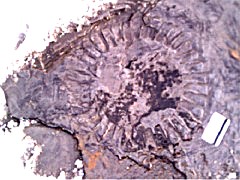|
|
|
|
||||||
| Strange fossils from Ordovician period Go to the photo page for detailed pictures. I am happy to provide to you these scanned 35 mm shots I took Last weekend. I found out that some details are better viewed when contrast is modified in photoshop, please experiment with these. Unfortunately the measuring tape that I thought would be usefull is more an annoyance in some of the shots. Take particular attention to the close-up of the projecting appendices (4,14) they are shape like fan blades and go uner each other, there is no visible outer wall.Also, there is a part of the matrix rock that is gone (11,6,5)on one of the specimen and we can see that an inch below the pattern of "spikes" is still there. Picture 8 and 3 can suggest that there is multiple layers of appendixes with some degree of offset from the following set. On picture 2 there seem to be something projecting from the ends of the blade or spikes. |
 |
|||||
| Can it be Ammonites? No, Ammonites have a spiral shape. There is no way tu obtain a closed circle using a section of Ammonite shell. |
They may be a sort of Archaeocyathid! They may be related to Archaeocyathids, although they disapeared during the Cambrian period. They had a skeletton with radiating walls, but there was an outer wall wich is not visible. Nothing seems visible in the center region, but the elevation from the matrix is the same as the projecting "arms" so it must have been the same density (same resistance to erosion). I still don't know what they are. |
|||||
Could it be the mouthpiece of Anomalocaris? Are they some sort of Scyphozoan (medusas) |
It could be a sponge, the presence of small incrustations called "spicules" could prove that. I have observe something that looks like spicules but I am not sure what they are (see photo page).I still have no idea it might be some kind of sea plant attached to the bottom, but corals specialists say there is no specimen that comes close to these two. That is the main reason for this site, if you have a serious suggestion, please send me an e-mail. I am anxious to look into it. Thank you very much for youf interest. |
|||||